


SANZIO RAPHAEL 1483 -
Including:
Pietro
Perugino
and
Pintoricchio

xxxxxSanzio Raphael, one of the great artists and architects of the Italian High Renaissance, was born in Urbino, the son of a court painter. At the age of 16 he went to Perugia, where he worked as an assistant to the accomplished Umbrian artist Pietro Perugino. It was here that he painted his two large works Marriage of the Virgin and his Crucifixion. Both of these show the graceful influence of his master, and it was clear at this early stage that he possessed an extraordinary talent. To this period belongs the narrative paintings Vision of a Knight (in the National Gallery, London), The Three Graces, and St. Michael and St. George.
xxxxxBut it was during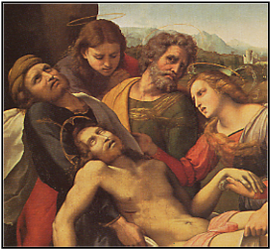 his four years’ stay in Florence (1504-
his four years’ stay in Florence (1504-
xxxxxIn about 1508, at the age of 25, he was called to Rome by Pope Julius II to produce a cycle of frescoes for the pope's living quarters in the Vatican Palace. Michelangelo was working on the ceiling of the Sistine Chapel at this time. His School of Athens (illustrated centre below), depicting one of the themes -
xxxxxIt was during this highly 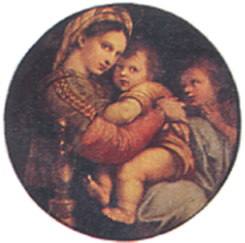 productive, almost feverish period that he designed a series of tapestries for the Sistine Chapel depicting various Acts of the Apostles. These were used to cover the side walls during ceremonial occasions and were woven in Brussels. Seven of the ten fine watercolour cartoons (preparatory drawings) made for these tapestries can be seen in the Victoria and Albert Museum in London. And it was at this time, too, that he painted, among other works, the Triumph of Galatea for the villa Farnesina, a portrait of Julius II, and a series of Madonnas, including another of his masterpieces, the bold and richly-
productive, almost feverish period that he designed a series of tapestries for the Sistine Chapel depicting various Acts of the Apostles. These were used to cover the side walls during ceremonial occasions and were woven in Brussels. Seven of the ten fine watercolour cartoons (preparatory drawings) made for these tapestries can be seen in the Victoria and Albert Museum in London. And it was at this time, too, that he painted, among other works, the Triumph of Galatea for the villa Farnesina, a portrait of Julius II, and a series of Madonnas, including another of his masterpieces, the bold and richly-
xxxxxRaphael worked alongside Bramante when he was designing the new St. Peter's Basilica, and in 1514, following Bramante's death, he was appointed chief architect of this project. His revised plans were never used, in fact, but he designed a number of buildings in Rome including the Chigi Chapel in Santa Maria del Popolo, the Palazzo Vidoni and the Villa Madama. The following year, to add to his workload, he was put in charge of all the excavation of antiquities in and around Rome.
xxxxxHis portraiture and large production of mythological and religious works inspired not only many of his contemporaries, but also influenced the work of future masters, such as Rubens, Poussin and Rembrandt. He is best remembered today for his frescoes and tapestries in the Vatican, and his numerous Madonnas, but his brilliant portrait of Baldassare Castiglione (1528 H8), painted in 1516 and illustrated below, clearly shows that he was also an accomplished artist in this genre.
xxxxxHe died in 1520 on his 37th birthday, an admired and respected artist. His funeral service was held in the Vatican and his final great work, the unfinished altarpiece The Transfiguration, was placed at the head of the bier. He was buried in the Pantheon at Rome.
xxxxxIncidentally, as noted earlier, while Raphael was painting frescoes in the apartments of the Vatican Palace, around about 1509, Michelangelo was working on the ceiling of the Sistine chapel. It is said that in his School of Athens two of the ancient philosophers bear an uncanny likeness to the painter and his fellow worker Michelangelo! There are a number of works by Raphael in the National Gallery in London.
xxxxxSanzio Raphael was one of the greatest artists of the classical period of the Italian Renaissance. As a teenager he was a pupil of the Umbrian painter Pietro Perugino. To this period belongs his two large works Marriage of the Virgin and his Crucifixion, and his narrative painting Vision of the Knight. But it was when he moved to Florence and was able to study the works of Leonardo da Vinci, Michelangelo and Masaccio, that his work became noted for its outstanding eloquence, harmony and subtle use of light and shade. Here he produced La Belle Jardinière and his Madonna of the Goldfinch. In about 1508 he was summoned to Rome by Pope Julius II. There he painted a series of frescoes for the papal apartments, and his masterpiece The School of Athens, a work of balance and order. Famous, too, are a number of Madonnas, and the series of tapestries he produced for the Sistine Chapel, at the time when Michelangelo was working on the ceiling. As an architect he worked for a time with Bramante, and he designed a number of buildings in the city. His work influenced, above all, Rubens, Poussin and Rembrandt.
xxxxxRaphael’s teacher, the Umbrian Pietro Perugino (c1450-
xxxxxIn his early years, 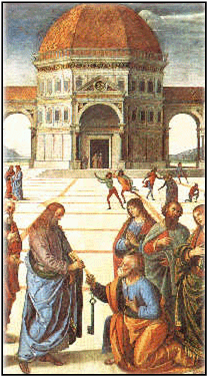 Raphael
Raphael 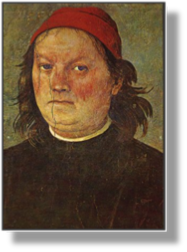 was clearly influenced by his teacher, the Umbrian artist Pietro Perugino (c1450-
was clearly influenced by his teacher, the Umbrian artist Pietro Perugino (c1450-
xxxxxFrom about 1479 he began work in Rome for Pope Sixtus IV, and one of his major works, Christ Giving the Keys to St. Peter (detail illustrated), has survived in the Sistine Chapel, still admired for the simplicity of its composition. Three other narrative scenes by him, painted behind the altar and completed in the early 1480s, were later destroyed by Michelangelo to make way for his Last Judgement.
xxxxxHe moved to Florence 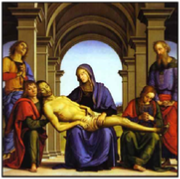 in 1486 and it was here that he was at his most productive. His works during this period include the Madonna with Saints and Angels, Agony in the Garden, The Virgin in Glory with Saints, The Marriage of the Virgin, and his famous Pietà for the Church of the Convent of San Giusto, Tuscany (illustrated), paintings which attest to the purity and clarity of his style and his penchant for vast landscapes. His last major work is thought to be the fresco The Nativity, now in the National Gallery in London.
in 1486 and it was here that he was at his most productive. His works during this period include the Madonna with Saints and Angels, Agony in the Garden, The Virgin in Glory with Saints, The Marriage of the Virgin, and his famous Pietà for the Church of the Convent of San Giusto, Tuscany (illustrated), paintings which attest to the purity and clarity of his style and his penchant for vast landscapes. His last major work is thought to be the fresco The Nativity, now in the National Gallery in London.
xxxxxWhile in Florence, Perugino made frequent visits to Perugia, and it is from this city that he derived his name. (He was actually born Pietro Vannucci). Amongst his work at Perugia is a richly-
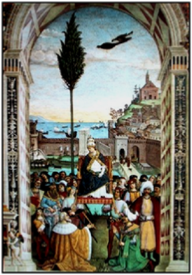
xxxxxAnother Italian artist who was born in Perugia was Pintoricchio (1454-




Acknowledgements
Raphael: The Entombment of Christ -
H7-